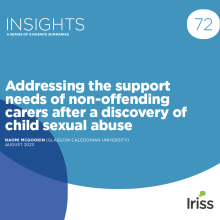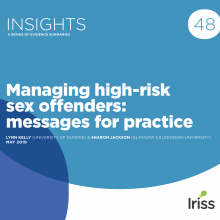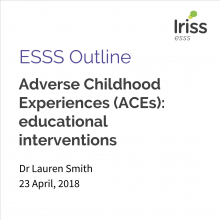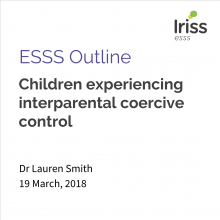Summary
This Outline explores the relationship between adults who access child sexual abuse images online and those who commit contact offences. It identifies examples of good practice for social workers handling cases in this context.
Multiple studies are identified that outline the complex relationship between accessing child sexual abuse images online and committing contact offences, including explanations of why research of this nature is limited in applicability in the social work context for risk assessment purposes. The resources outlined include recommendations around indicators of risk to children, signs of sexual abuse, and some evidence around the impact of being the victim of child sexual exploitation as the victims of child sexual abuse are those on both sides of the screen.
The Outline also identifies other potentially useful tools to use in social work, and relevant Iriss resources for social workers supporting children affected by child sexual abuse.
Introduction
This evidence summary seeks to address the following question: what risk do parents and carers who access child sexual abuse images online pose to the children in their care?
About the evidence presented below
There is a general lack of research on sexual interest in children among the general adult population, with very few studies including female participants or exploring the use of child sexual abuse images. Specifically, there is little evidence around factors that distinguish men who act upon their self- identified sexual interest children from those who do not. Research in the area communicates this inconsistency; being sexually interested in children does not necessarily lead to sexual abuse of children, but some do express their interests by committing child sexual abuse offences1.
Several studies point to the inconclusive nature of the evidence around whether pedophilic or hebephilic interests escalate into contact offending2. This is due to several reasons, including weakness of correlational studies that imply evidence of the possession of child sexual abuse images is connected to committing child sexual abuse offences. It must also be noted that child sexual abuse is not only committed by people who are pedophilic3.
A significant limitation of the research around the link between accessing child sexual abuse images and committing contact child sexual abuse offences is that studies tend to be based on populations of convicted offenders of one or both activities. This both limits the applicability of the research findings to people who have not been convicted, as characteristics may differ between undetected and detected offenders, and does not necessarily present an accurate picture, as conviction rates tend to underestimate the true offending rates4.
Terminology
Care has been taken throughout this summary to refer to ‘child sexual abuse images’ rather than ‘child pornography’ to reflect the non-consensual and illegal nature of the content. However, child pornography was included within the search terms when collecting evidence and is included in the publication titles provided within this summary. This summary refers to ‘contact sexual abuse’ to differentiate between viewing illegal images and personally committing abuse. Some publications refer to technology-assisted child sexual abuse to better reflect the nature of abuse that is not always online-only.
Accessing resources
We have provided links to the materials referenced in the summary. Some of these materials are published in academic journals and are only available with a subscription through the The Knowledge Network with a NHSScotland OpenAthens username. The Knowledge Network offers accounts to everyone who helps provide health and social care in Scotland in conjunction with the NHS and Scottish Local Authorities, including many in the third and independent sectors. You can register here.
Background
There is considerable concern that people who access images of child sexual abuse online may also sexually abuse children in their care. When parents and carers are suspected of accessing images of child sexual abuse, social workers are required to assess the potential risk to children and take appropriate steps to prevent harm and ensure they are not in danger. This Outline was commissioned to provide evidence around the relationship between accessing child sexual abuse images and contact child sexual abuse, and to provide resources around good practice for social workers working in this context.
Evidence
Causal links between accessing child sexual abuse images and contact child sexual abuse
Some studies have identified different reasons for viewing child sexual abuse images, including the material serving as a blueprint for future sexual activities, or serving as a substitute for pedophilic behaviour. However, although there is evidence to suggest that child-attracted men in particular are liable to molest their own children, the extent to which people who access child sexual abuse images are sexually attracted to children (i.e. pedophiles) is unclear.
Great care must be taken to distinguish between those who access child sexual abuse images and never act upon such images by committing ‘hands-on’ offences, and those who can be termed ‘dual offenders’. Lowenstein (2005) emphasises that it is important “not to believe that one can predict with any degree of certainty anything based on the downloading of images from the internet”6. The sources listed below provide an overview and specific insights into research around the link between viewing child sexual abuse images and committing contact offences. Some provide recommendations for good practice for assessors.
Bailey, J.M, Bernhard, P.A and Hsu, K.J (2016) An internet study of men sexually attracted to children: correlates of sexual offending against children. Journal of Abnormal Psychology, 125(7), pp.989-1000 (Available with NHSScotland OpenAthens username)
This paper reports the findings of an Internet survey of 1,102 men sexually attracted to children that investigated offences they had committed related to child pornography and sexual contact with children. A limitation of this study is that it is reliant on self-reporting. Nonetheless, although most participants reported no offences, their rate of offences was much higher than that expected for adult-attracted men. Demographic factors associated with higher offending rates are older men, men who had repeatedly worked in jobs with children, men who had repeatedly fallen in love with children, and men who had often struggled not to offend (though these are causal and not demonstrably correlated). Strong predictors of offending were attraction to male children, relative attraction to children versus adults, and childhood sexual abuse experiences.
Child Exploitation and Online Protection Centre (2012) A picture of abuse: a thematic assessment of the risk of contact child sexual abuse posed by those who possess indecent images of children (pdf)
This thematic assessment explores the risk of contact child sexual offending posed by those who possess still and moving indecent images of children (IIOC). It looks at the ways in which this risk is managed by the police service and others involved in child protection and the criminal justice process.
Middleton, D (2009) Linkages between viewing indecent images of children and contact sexual abuse: issues from research. Compendium of Articles Research Findings on Child Abuse Images and Sexual Exploitation of Children Online. Bangkok: ECPAT International (pdf)
This review provides an outline of research findings around the relationship between accessing child sexual abuse images and committing contact child sexual abuse offences.
Key findings and conclusions from this review of evidence include:
- In relation to the possible escalation of viewing behaviour into contact offending, the evidence is inconclusive
- Some Internet offenders move into contact sexual abuse or are involved in both online and offline abuse, but the majority do not
- There is only limited support for basing risk assessment on the severity of the image depicted or the size of collection
- Most people who view indecent images do not also personally engage in contact child sexual abuse. However all who view such images fuel the market for the production of new images and therefore more sexual abuse. Thus, all who view such images should be prosecuted rather than cautioned
- Assessors should look for evidence of dynamic risk factors, particularly intimacy deficits, anti-social cognitions and personality, and previous conviction history in order to identify those more likely to become involved in both viewing and contact offences
Neutze, J et al. (2011) Predictors of child pornography offenses and child sexual abuse in a community sample of pedophiles and hebephiles. Sexual Abuse: A Journal of Research and Treatment, 23(2), pp.212–242 (Available with NHSScotland OpenAthens username)
This study of 155 self-referred pedophiles and hebephiles may be useful reading around the dynamic risk factors for adults with previous history of child sexual abuse in reoffending.
A limitation of this study is that the sample used for the lifetime history comparison did not include a group who had never committed child pornography or child sexual abuse offences. This means it is not possible to identify any factors “that distinguish pedophiles or hebephiles who have ever acted upon their sexual interests by committing sexual offences from those who did not” (p.233). The study is also reliant on self-reporting.
Seto, M. C., & Eke, A. W. (2005). The criminal histories and later offending of child pornography offenders. Sexual Abuse: A Journal of Research and Treatment, 17(2), pp.201–210. (Available with NHSScotland OpenAthens username or online)
This study of 201 adult males convicted of accessing child sexual abuse images reports to be the first ever to report on later offending. It sought to identify the likelihood that offenders will later commit a contact sexual offence. Although the overall rate of sexual recidivism was low, the study found that offenders with prior criminal records were “significantly more likely to offend again in any way”, and that “offenders who had committed a prior or concurrent contact sexual offence were the most likely to offend again”. The authors state that their findings “contradict the assumption that all child pornography offenders are at very high risk to commit contact sexual offences involving children” (p.208).
Limitations of the study include that the researchers only had access to official records and could not gain insight into psychological variables that may influence the likelihood of reoffending. Additionally, the study sample was of men charged and convicted of child pornography offences, and did not include people who had offended but not been charged or convicted.
Wurtele, S.K, Simons, D.A and Moreno, T (2014) Sexual Interest in children among an online sample of men and women. Sexual Abuse: A Journal of Research and Treatment, 26(6), pp.546–568 (Available with NHSScotland OpenAthens username)
This paper presents the results of an online questionnaire of 173 men and 262 women that explores the extent to which men and women in the general population report sexual interest in children. It identifies developmental experiences associated with self-reported sexual interest. Six per cent of men and two per cent of women who responded to the questionnaire indicated some likelihood of having sex with a child if they were guaranteed they would not be caught or punished.
Limitations of this study include that it is based on a convenience sample, but the online method of recruitment may also have been a strength in that participants may have been more likely to disclose information in anonymity and comfort.
Indicators of risk to children
The evidence above indicates that accessing child sexual abuse images does not necessarily mean someone is committing contact child sexual abuse, but likewise viewing child sexual abuse images does not always exist in isolation7. In some instances the level of risk may change, because whether sexual motivations are acted upon can depend on changing factors such as opportunity8.
The sources below explore other indications of child sexual abuse in suspected adult offenders and child victims that may support social workers’ use of knowledge in practice, to support planning for family safety9.
Hall, R.C.W and Hall, R.C.W (2007) A profile of pedophilia: definition, characteristics of offenders, recidivism, treatment outcomes, and forensic issues. Mayo Clinic Proceedings, 82(4), pp.457–471 (pdf)
This article provides a useful overview of pedophilia, its rate of occurrence, and the characteristics of pedophiles and sexually abused children. It also explains how researchers determine if someone is a pedophile, potential treatments for pedophiles and sexually abused children, and evidence around the risk of additional sexual offences, and provides an overview of several sexual risk actuarial and assessment tests.
Henshaw, M, Ogloff, J.R.P and Clough, J.A (2017) Looking beyond the screen: a critical review of the literature on the online child pornography offender. Sexual Abuse, 29(5), pp.416–445 (Available with NHSScotland OpenAthens username)
This article reviews the current literature around those who access child sexual abuse images. It explores the similarities and differences in characteristics of Child Pornography and Child Contact Sexual Offenders to inform the development of sexual offending assessment and treatment frameworks. This may be useful to social workers because it provides a detailed overview of the evidence around socio-demographic characteristics, psychosocial background and psychological characteristics of different offenders and the relationship between child pornography and contact sexual offending. It also explains the difficulties and limitations of research seeking to identify the risk of offenders.
Houtepen, J.A.B.M, J.J Sijtsema and Bogaerts, S (2014) From child pornography offending to child sexual abuse: a review of child pornography offender characteristics and risks for cross-over. Aggression and Violent Behaviour, 19(5), pp.466-473 (Available with NHSScotland OpenAthens username)
This review provides concrete directions for individual risk assessment and treatment planning around child pornography offending. It explores risk factors for cross-over from sexual deviance/fantasy to criminal behaviour.
NHS Choices (2016) Spotting signs of child sexual abuse (website)
This website provides information about spotting signs of sexual abuse in children. They include:
- Changes in behaviour – a child may start being aggressive, withdrawn, clingy, have difficulties sleeping or start wetting the bed.
- Avoiding the abuser – the child may dislike or seem afraid of a particular person and try to avoid spending time alone with them.
- Sexually inappropriate behaviour – children who have been abused may behave in sexually inappropriate ways or use sexually explicit language.
- Physical problems – the child may develop health problems, including soreness in the genital and anal areas or sexually transmitted infections, or they may become pregnant.
- Problems at school – an abused child may have difficulty concentrating and learning, and their grades may start to drop.
- Giving clues – children may also drop hints and clues that the abuse is happening without revealing it outright.
NSPCC (2017) Sexual abuse: signs, indicators and effects (website)
This resource from the NSPCC provides an overview of signs of sexual abuse in children, evidence from research around the effects of child sexual abuse, particularly around the nervous system, self harm and sexual health. It provides links to child protection research, leaflets, guidance, evaluations and safeguarding resources on sexual abuse.
Good practice around child sexual abuse images and potentially at-risk children
British Association of Social Workers (BASW) (2013) Social workers need more support in dealing with online abuse of children (website)
This article reports on a survey by the British Association of Social Workers (BASW) that found that almost half (49%) of social workers said that 25% of their sexual abuse cases now involve some form of online abuse and that 36% felt they did not know the right questions to ask to identify and assess online sexual abuse. The article reports that the NSPCC is developing elearning resources to support professionals (possibly these around child sexual exploitation).
Featherstone, B, White, S and Morris, K (2014) Re-imagining child protection: towards humane social work with families. Bristol: Policy Press. ISBN: 978-1447308010 (Available from NHS Scotland Library)
This book explores how social workers can take a family-minded approach to the practice of child protection, applying relational practice, professional discretion and empathy.
Hamilton-Giachritsis, C et al. (2017) “Everyone deserves to be happy and safe”: A mixed methods study exploring how online and offline child sexual abuse impact young people and how professionals respond to it (pdf)
This study, published in November 2017 and conducted by researchers at the University of Bath, University of Bristol and CEOP for the NSPCC, explores the impact of sexual abuse on children and professionals’ responses to technology-assisted child sexual abuse (TA-CSA). Although the report focuses on the needs of victims of TA-CSA specifically, it may be a useful resource for social workers wanting to better understand the impact of child sexual abuse more generally, and the report provides good practice recommendations for social care, therapy and interventions.
Kwhali, J et al. (2016) Child sexual abuse and exploitation: knowledge, confidence and training within a contemporary UK social work practice and policy context. British Journal of Social Work, 46(8), pp.2208–2226 (Available with NHSScotland OpenAthens username)
This paper reports the findings of a series of interviews and focus groups with social workers, first-line, middle and senior managers and chairs of local safeguarding boards, exploring practice issues, knowledge and confidence, and effective support, supervision and training around child sexual abuse cases. It provides recommendations for training plans, impact evaluation and inter-agency working.
London Safeguarding Children Board (no date) Guidelines: assessing children and families affected by individuals viewing child sexual abuse images on the internet (pdf)
These guidelines include guidance for the assessment where child internet abuse is suspected, including timelines for actions and the kind of information that should be collected, including models for gathering information from the family members. It provides a comprehensive set of indicators around risk assessment.
Martin, J. (2016). Child sexual abuse images online: Implications for social work training and practice. British Journal of Social Work, 46(2), pp.372-388 (Available with NHSScotland OpenAthens username)
This paper reports on the findings of a qualitative study into 14 Ontario social workers’ understandings and experience of dealing with cases relating to child sexual abuse images online. There was a predominant concern that they did not receive adequate training around this specific topic, and despite having all had considerable training and experience in child sexual abuse generally, online images was an area they did not feel able to assess for and respond to. The paper provides implications for social work training and practice and concludes with a call for the recognition of child sexual abuse images online as a new area in social work practice requiring additional research and specialised training.
Martin, L et al. (2014) Social workers’ knowledge and confidence when working with cases of child sexual abuse: what are the issues and challenges? (pdf)
This report funded by the NSPCC is the same study presented by Kwahli et al. (above) about the confidence, knowledge and skills of social workers around child sexual abuse. It includes recommendations for best practice and change around defining child sexual abuse, therapy and support, caseloads, and equality and diversity issues.
Smith, L (2017) Child sexual abuse and good practice for social workers (website and pdf)
This Iriss Outline explores good practice approaches to investigating child sexual abuse that may minimise harm or distress to the child (and non-abusing parent). It draws on Serious Case Reviews, academic literature and online resources from key organisations, providing links to examples of good practice and brief outlines of relevant content within the sources.
Other useful resources
Brook (2015) Sexual behaviours traffic light tool (website)
This resource has been developed by Brook, a young people’s health and wellbeing organisation, to categorise the sexual behaviours of young people and is designed to help professionals:
- Make decisions about safeguarding children and young people
- Assess and respond appropriately to sexual behaviour in children and young people
- Understand healthy sexual development and distinguish it from harmful behaviour
National Institute for Health and Care Excellence (NICE) (2017) Child maltreatment: when to suspect maltreatment in under 18s (website)
This guideline covers the signs of possible child maltreatment in children and young people aged under 18 years. It aims to raise awareness and help health professionals who are not child protection specialists to identify the features of physical, sexual and emotional abuse. NICE have also produced a flowchart to outline the process of assessing risk and need in relation to child abuse and neglect.
NSPCC (2016) Someone to lean on: advice for professionals giving therapeutic support to children who have been sexually abused (pdf)
A short guide of tips for social care and mental health practitioners to support them when working with children and their families after sexual abuse.
Stop It Now! (2017) Publications, resources, posters, leaflets (website)
Stop it Now! has produced the following public information leaflets, posters and to raise awareness to and prevent child sexual abuse. These include information for people who have been visited by the police or arrested for possible internet offences, around first steps to getting the right support and advice about their behaviour, and first steps for the families and friends of these people. There is also a leaflet about tell tale signs that someone may be using the new technologies in sexually inappropriate or harmful ways.
Footnotes
- Neutze, J et al. (2011) Predictors of child pornography offenses and child sexual abuse in a community sample of pedophiles and hebephiles. Sexual Abuse: A Journal of Research and Treatment, 23(2), pp.212–242 (Available with NHSScotland OpenAthens username)
- Middleton (2009) Compendium of articles: research findings on child abuse images and sexual exploitation of children online (pdf)
- Seto (2008) in Babchishin, K.M, Hanson, R.K. and VanZuylen, H (2015) Online child pornography offenders are different: a meta-analysis of the characteristics of online and offline sex offenders against children. Archives of Sexual Behavior, 44(1), pp.45–66 (Available with NHSScotland OpenAthens username)
- Goller, A et al (2016) Criminal recidivism of illegal pornography offenders in the overall population: a national cohort study of 4612 offenders in Switzerland. Advances in Applied Sociology, 6, pp.48-56 (Open Access)
- Quayle, E and Taylor, M (2002) Child pornography and the internet: perpetuating a cycle of abuse. Deviant Behaviour, 23(4), pp.331-362 (full text available via ResearchGate)
- Lowenstein, L (2005) Recent research into the downloading of child pornographic materials from the internet. Community Safety Journal, 4(3), pp.14-24
- Owens, J (2016) Investigative aspects of crossover offending from a sample of FBI online child sexual exploitation cases. Aggression and Violent Behavior, 30, pp.3–14 (Available with NHSScotland OpenAthens username)
- Smallbone, S, Marshall, W.L and Wortley, R (2008) Preventing child sexual abuse: evidence, policy and practice. Oxon: Routledge, p.40 (Available from the National Library of Scotland and other libraries)
- Levenson, J.S and Morin, J.W (2006) Risk assessment in child sexual abuse cases. Child Welfare, 85(1), pp.59-82 (Available with NHSScotland OpenAthens username)
Acknowledgements
Thank you to Donna McEwan and Claire Lightowler at the Centre for Youth and Criminal Justice for signposting some relevant resources.




